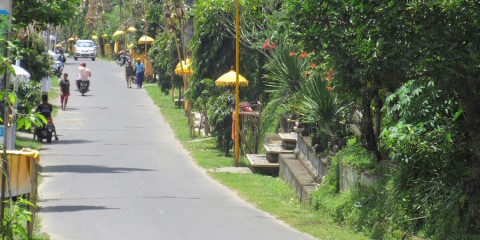
Tagalalang, Bali, Indonesia
In my last week at Bali, I took a lot of pictures. Around Ubud and in Pemuteran, mostly, but a few around Seminyak again as I did some businessy stuff before my flight out. Rather than provide another long insufferable writing piece, I’m going to offer up some shorter peppier photo essays. I use “photo essays” because it makes what’s about to happen sound fancy.
The first one: my lucky discovery of a Full Moon Festival in the town of Tegalalang just north of Bali. I had decided to go on an extended motorbike ride, cause it’s so much fun, drove past the rice terraces and noticed on my GPS that there was a little road that circled back to town through the country side. Perfect! Lovely drive, plus I happened to do it during a special day called Purnama., or Full Moon Festival. I came across this little village and the place was a’bustling! I parked my “iron horse”, and as I walked into a temple, a very nice man pulled me over and told me I had to change my ways if I wanted to stick around. Namely put on a hat and wear a sarong, which he gave me. So, I did that and wandered around the festivities, talking with people who were very friendly and welcoming. In fact, one guy pulled me over to a beruga (sitting platform) and offered me coffee. I ended up chatting with this group of men, who were taking a break from all the setting up, for about half an hour. All were interested in where I came from, and why I was there. Compared to other white visitors, an American was a relative novelty here, it seems. One guy wanted to talk Elvis. Another Arnold Schwarzegger. Another about the climate in America. I in turn asked them about the festival and about their families. Their English wasn’t great, but leagues better than my Balinese or Indonesian. (Evidently, English is mandatory at schools here until high school, and many take more classes so they can interact with tourists). Anyway, I promised a photo essay, so here it is. My shots taken before the festival (which wasn’t going to start until later that night). The temple is called Pura Sanghyana Alang and is in Tegalalang, Bali, just north of Ubud.
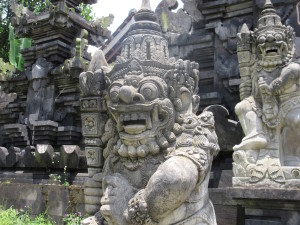
Puras all over Bali have various statues from both Balinese Hinduism and the older animism. This one was guarding an ancillary temple, where the people were preparing everything for the Pura.
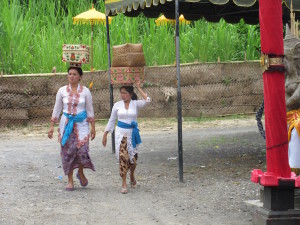
Women carry nearly everything on their heads. In this case, they are carrying offerings to the temple on their heads, because the head is the most sacred part of the body. So, not only is the head a good place to carry stuff, it’s respectful to their worship.
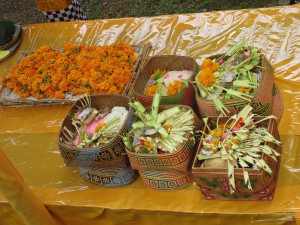
The ubiquituos offering bowl. Women, mostly, put these out before every meal, at the driveway, in front of businesses, on temples, on the street,….everywhere. Always has these kinds of ingredients plus incense burning. (As with all these photos, click on them to make them bigger)
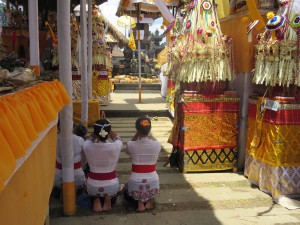
Women praying before they go into the temple. There isn’t ONE altar, like with Buddhism or Christianity. They have multiple altars, and while I couldn’t figure out why, it seems that they do serve different devotional purposes.
I didn’t take as many pictures of people as I could have, because I don’t have that nosy photojournalist mojo going for me. Plus, I really thought I was being intrusive to take pictures of people while they were going about a sacred endeavor. Maybe not, but…still.
Back on the road, I took a lovely hour long ride through the countryside. And here’s what I saw!
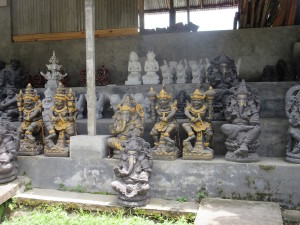
North of Ubud there is whole district of small factories, workshops really, that make the stone walls, towers and whatnot that temples need.
Every village has at least three temples. Every village. That’s a lot of temples, not to mention all the big ones and tiny ones, nor all the shrines that most families have in their homes, somewhere. So there’s a thriving business for temple replacement materials.
Since you asked, the three purrs are:
Pura Puseh: A temple dedicated to Lord Vishnu (the preserver). Vishnu can take on different incarnations, and can move freely between the earthly world and the heavenly world. All Pura Pusah are located at the upper end of the village, as the river/stream runs. Vishnu’s ability to settle the outburst of evil powers makes him the right deity for the entrance to the village.
Pura Desa: A temple dedicated to Lord Brahma (the creator). Pura Desa are located in the middle of the village, and people gather there to pray as well as hold community meetings. Lord Brahma is the god of creation, so he’s a good one to have on your side.
Pura Dalem: A temple of Lord Siva (Deva Siva), the destroyer. Pura Dalem guard the downstream exit / end of a village. Believers believe that Siva purifies ones ancestors and converts them into deities. He judges the good and evil deeds of a person and decides the punishment/reward. So, again, good to have on your side.
I talked with a Spanish hotel manager, who has lived in Bali for 2 years, and he told me that Balinese spend up to 1/3 of their annual income on donations to support their religion, including temple maintenance and the ceremonies that happen at their pure. That seems like a lot for a relatively poor population.
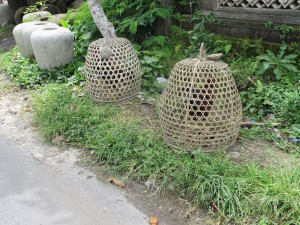
Roosters under basket arrest. I couldn’t figure out exactly why they do this. I know they keep roosters for the hens, they sell roosters to other farmers, and they also – long tradition here – sell roosters for cockfights.
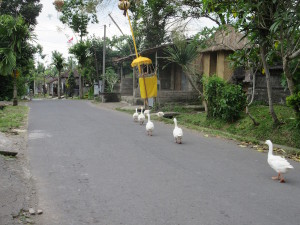
Toward the end of the drive, I came across these guys. They seemed to be intent with their march, but I had no idea where they were going. Didn’t mind me motoring by.
And that was it. Soon thereafter I entered Ubud, and bought a Coke Zero. 🙂
Xi’an is an Important City in China. Here are the opening lines from the Wikipedia entry:
“One of the oldest cities in China, with more than 6,000 years of history, the city was known as Chang’an before the Ming dynasty. Xi’an is one of the Four Great Ancient Capitals of China, having held the position under several of the most important dynasties in Chinese history, including Zhou, Qin, Han, Sui, and Tang. Xi’an is the starting point of the Silk Road and home to the Terracotta Army of Emperor Qin Shi Huang.”
Most of you have heard of it because it’s where thousands of terra cotta soldiers were buried with the China’s first emperor in 300 BCE, that guy Qin. I’m including just a few pictures of the chalky soldiers that greeted us with stony expressions, since you can get all you need with a search here.
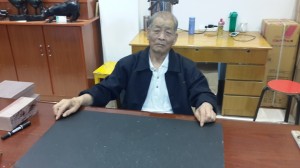
The Guy: This is the farmer that discovered the site in 1976. Despite his playful demeanor, and the sign that said, “No Autographs!”, I got his autograph! But since I can’t read Chinese, I’m not really sure what he wrote.
But Xi’an is much more than these dusty relics of a past megalomaniac’s vain vision. In nearby Yan’an live a people who have dwelled for millennia in caves carved out of mountains – and still live in them – although the family we visited also had a house in front of their cave. The mom (pictured below on a nifty tractor) preferred to live in the cave while her daughter-in-law and grandchildren preferred to live in the house. Her son was away working in a coastal city, and her husband passed away. They make their money showing off their home to our tour agency, as well as growing and selling persimmons. ALSO featured below.
Xi’an is also known for it’s culture, and so we saw a wonderful show featuring music, dance and theater of the Tang Period at the – surprise! – Tang Palace Theater. This is something I really wanted to see. I know it’s touristy, but I like music and theater and wanted to see traditional forms of it. Not just the ubiquitous K-Pop like genres. This was a dinner theater, retail price about $70 per person, although I’m sure our tour agency got a smoking’ hot deal. The food was dim sum, which was tasty. However, the highlight of the evening (aside from the show) was our grumpy, sullen server who went to no lengths at all to hide her displeasure at, we never found out. She looked on our table with dripping disdain, and it became a Thing for us to see how grumpy she would get. No tip for her!
Our penultimate stop in Xi’an was the Great Wild Goose Pagoda, originally built in 652 to house the original Buddhist texts and statues that Xuanzang (remember him? Devout, spoke softly, but could whip your butt and take your money in chess.) brought with him from India.
Pictures of Pagoda – forthcoming!
Our final stop in Xi’an was the Muslim Street, where the oldest mosque in China hid amidst the warren of tiny alleys, streets and walkways, filled with every conceivable product or food. I bought a pair of fake Beat headphones for $3. Score! And there were lots of these knock offs around. Walking through this section of town was intense – sometimes dark, continually noisy with yells, honking and sizzling from the grills. I loved it!
Pictures of Muslim Street – forthcoming!
There are loads of shrines and temples in Kyoto, so not all of them get the attention from the tourists. This one has just one tourist enjoying it. The door was open, and no one is here to greet me. No ticket booth, no signs saying “do not walk here”, no maintenance men. Just me and cicadas. With the sounds of distant thunder, maybe bringing rain, maybe just “heat” thunder as we used to call it in Michigan summers.
I got here by sheer luck. Eschewing the tourist bus that was recommended, I just started walking and got “lost” in a medium sized neighborhood. I kinda had my compass bearings set for a southeasterly amble, trusting that eventually I would run into the main Marutamachi / Higashioji-dori intersection. Which we all do, at some point in our lives. And I came across this open gate that looked like a driveway into some sort of school. Nothing said “do not enter”, so I entered. And it turned out to be this Yoshida Shrine! (shorter wiki entry in English)\
I know next to nothing about the history of shrines like this. I’ve read a few books, and I know a few facts (mostly about eras, patronage, various deities both Shinto and Buddhist and architecture). But what I am most interested in is what I know least about – the meanings people throughout the century created and reified in Shrines like this one.
And, I can’t ignore this one, I keep thinking of what it was like here during the early 1940s. I KNOW everyone has moved beyond WWII, and I wasn’t even alive then, but after a few days absorbing the history of Hiroshima, knowing Kyoto was on the short list for an A Bomb too, I wonder what life must have been like. How many families in this neighborhood, who asked for safety from this shrine, lost their men to the war? Was this a recruitment center for the armies that fought against the US? After the war, what role did this Shrine play as Japanese society rebuilt it’s entire being? It’s sense of what it meant to be Japanese.
As I’m typing off behind this tree, a Japanese man, middle aged, strides up to the shrine from the gate 100 yards to the left. It’s about 5pm, so maybe he’s coming home from work. He’s dressed in casual light clothing, not a business suit, so maybe he’s retired. He puts his bag down at his feet. Takes off his hat. Stands quietly with eyes closed (yes, I can see all this). He bows slightly. Stands again. Lightly claps his hands twice. Stands again. Seems to be reflecting or deliberating or asking, quietly. After 3-4 minutes he bows again, picks up his bag, and walks off in another direction. I wonder who he is. What he does. What kind of life he has led here, while I have led mine on the other side of the globe. We could be the same age. Curious.
I don’t have any insights or conclusions here. It’s a beautiful, peaceful day in Kyoto, Japan this last day of July, 2014. I’m on a year long trip around the world with some desires and goals, but no real overall agenda. I’m not trying to “find myself”, but I do want to put myself in unfamiliar places for long periods of time to see if more of me emerges, the parts of me that have been quiet for a long time, or maybe forever. There’s a Buddhist homily I really like: the useful part of the bowl is the empty space. I think in this trip I want to create empty space; to let go of old familiar beliefs and limitations and clinging, and then notice what else comes, maybe meekly, to fill it.
So that’s what I ask for today. To create some empty space. And, amid a crowded, frantic city with tens of thousands of tourists clambering to see as many temples as they can…..somehow I found my own, private, quiet, ancient Kyoto Shrine.
